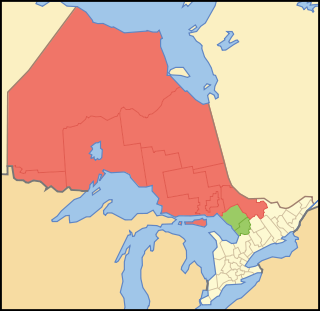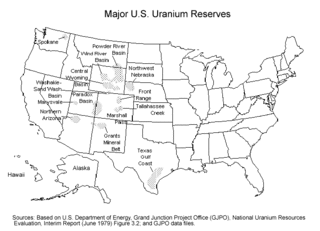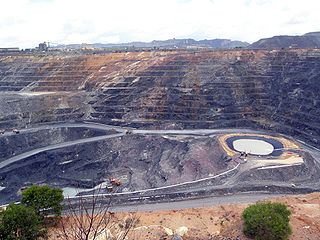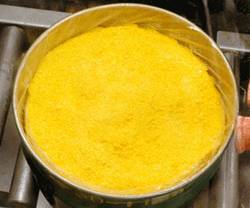Related Research Articles

Northern Ontario is a primary geographic and quasi-administrative region of the Canadian province of Ontario, the other primary region being Southern Ontario. Most of the core geographic region is located on part of the Superior Geological Province of the Canadian Shield, a vast rocky plateau located mainly north of Lake Huron, the French River, Lake Nipissing, and the Mattawa River. The statistical region extends south of the Mattawa River to include all of the District of Nipissing. The southern section of this district lies on part of the Grenville Geological Province of the Shield which occupies the transitional area between Northern and Southern Ontario. The extended federal and provincial quasi-administrative regions of Northern Ontario have their own boundaries even further south in the transitional area that vary according to their respective government policies and requirements. Ontario government departments and agencies such as the Growth Plan for Northern Ontario and the Northern Ontario Heritage Fund Corporation define Northern Ontario as all areas north of, and including, the districts of Parry Sound and Nipissing for political purposes, whilst the federal government, but not the provincial, also includes the district of Muskoka.

Algonquin people are an Indigenous people of Eastern Canada. They speak the Algonquin language, a divergent dialect of the Ojibwe language, which is part of the Algonquian language family. Culturally and linguistically, they are closely related to the Odawa, Potawatomi, Ojibwe, and Nipissing, with whom they form the larger Anicinàpe (Anishinaabeg). The Algonquin people call themselves Omàmiwinini or the more generalised name of Anicinàpe.
Rick Bartolucci is a former politician in Ontario, Canada. He was a Liberal member of the Legislative Assembly of Ontario from 1995 to 2014. He represented the riding of Sudbury and was a cabinet minister in the government of Dalton McGuinty.

Frontenac Provincial Park is a provincial park located near the town of Sydenham, north of Kingston, Ontario, Canada. This 5,350-hectare park is classified as a natural environment park, and lies on the Frontenac Axis, a topographic extension of the Canadian Shield connecting to the Adirondack Mountains. It features 22 lakes, over 700 species, and extensive areas of mixed forest, wetlands, and granite outcrops.
Paladin Energy Ltd is a Western Australian based uranium production company.

Uranium mining in the United States produced 173,875 pounds (78.9 tonnes) of U3O8 in 2019, 88% lower than the 2018 production of 1,447,945 pounds (656.8 tonnes) of U3O8 and the lowest US annual production since 1948. The 2019 production represents 0.3% of the anticipated uranium fuel requirements of the US's nuclear power reactors for the year.

An abandoned mine is a mine or quarry which is no longer producing or operational and, there is no responsible party to finance the cost to address the remediation and/or restoration of the mine feature/site. Terms and definitions vary though the common theme is that the cost to address the hazards is typically borne by the public/taxpayer/government.
Canada has an active anti-nuclear movement, which includes major campaigning organisations like Greenpeace and the Sierra Club. Over 300 public interest groups across Canada have endorsed the mandate of the Campaign for Nuclear Phaseout (CNP). Some environmental organisations such as Energy Probe, the Pembina Institute and the Canadian Coalition for Nuclear Responsibility (CCNR) are reported to have developed considerable expertise on nuclear power and energy issues. There is also a long-standing tradition of indigenous opposition to uranium mining.
Ardoch Algonquin is a non-status Algonquin (Anishinaabe) community that is located around the Madawaska, Mississippi and Rideau watersheds, north of Kingston, Ontario.

The Sacred Headwaters is a large subalpine drainage basin centred around Klappan Mountain of the Klappan Range in northern British Columbia. It is the source of three wild salmon rivers: the Skeena River, Nass River, and Stikine River. It is also referred to as the Klappan Valley, although the Klappan—a tributary of the Stikine River—is only one of the area's watersheds. Local Tahltan people call the area Klabona, which is loosely translated as "headwaters".

Mining is the biggest contributor to Namibia's economy in terms of revenue. It accounts for 25% of the country's income. Its contribution to the gross domestic product is also very important and makes it one of the largest economic sectors of the country. Namibia produces diamonds, uranium, copper, magnesium, zinc, silver, gold, lead, semi-precious stones and industrial minerals. The majority of revenue comes from diamond mining. In 2014, Namibia was the fourth-largest exporter of non-fuel minerals in Africa.
The Shabot Obaadjiwan First Nation, formerly known as the Sharbot Mishigama Anishinabe Algonquin First Nation and as the Sharbot Lake Algonquin First Nation, is a non-status Algonquin (Anishinaabe) community located north of Kingston, Ontario. It is currently in negotiation with the federal and provincial governments over claims to Aboriginal title in the area. Its chief is Doreen Davis.

The mineral mining industry is a crucial piece of the Economy of Niger. Exports of minerals consistently account for 40% of exports.

Radioactive ores were first extracted in South Australia at Radium Hill in 1906 and Mount Painter in 1911. 2,000 tons of ore were treated to recover radium for medical use. Several hundred kilograms of uranium were also produced for use in ceramic glazes.

Nuclear industry in Canada is an active business and research sector, producing about 15% of its electricity in nuclear power plants of domestic design. Canada is the world's largest exporter of uranium, and has the world's second largest proven reserves. Canada also exports nuclear technology within the terms of the Nuclear Non-proliferation Treaty, to which it is a signatory, and is the world's largest producer of radioactive medical isotopes.

The Victor Mine was the first Canadian diamond mine located in Ontario, and De Beers' second diamond mine in Canada. It is located in the Northern Ontario Ring of Fire, in the James Bay Lowlands 90 kilometres (56 mi) west of Attawapiskat in the remote northern part of the province. In June 2005, the Attawapiskat First Nation voted in favour (85.5%) of ratifying the Impact Benefit Agreement (IBA). Construction of the mine began in February 2006 which created 3200 positions; mining and operations will create around 400 permanent positions. The Victor Mine is an open-pit mine, with a processing plant, workshops, and an airstrip located on site. By 2013–2014 royalties collected from De Beers Victor Mine amounted to $226. At that time De Beers was continuing to pay off its "$1 billion investment to build the mine and from now until it closes, the company expects to pay tens of millions of dollars in royalties." The mine completed mining and processing in 2019 and has moved to a shut-down phase including demolition of infrastructure and rehabilitation of the site.

In 1944, uranium mining under the U.S military's Manhattan Project began on Navajo Nation lands and on Lakota Nation lands. On August 1, 1946, the responsibility for atomic science and technology was transferred from the military to the United States Atomic Energy Commission. Afterward, widespread uranium mining began on Navajo and Lakota lands in a nuclear arms race with the Soviet Union during the Cold War.
The Ring of Fire is the name given to a massive planned chromite mining and smelting development project in the mineral-rich James Bay Lowlands of Northern Ontario. The Ring of Fire development would impact nine First Nations, and potential developers are required to negotiate an Impact Benefit Agreement with these communities prior to development. The region is centred on McFaulds Lake, near the Attawapiskat River in Kenora District, approximately 400 kilometres (250 mi) northeast of Thunder Bay, about 70 kilometres (43 mi) east of Webequie, and due north of Marten Falls and Ogoki Post, which is near/on the west of James Bay.
The world's largest producer of uranium is Kazakhstan, which in 2019 produced 43% of the world's mining output. Canada was the next largest producer with a 13% share, followed by Australia with 12%. Uranium has been mined in every continent except Antarctica.

Mining is important to the national economy of Mongolia. Mongolia is one of the 29 resource-rich developing countries identified by the International Monetary Fund and exploration of copper and coal deposits are generating substantial additional revenue. Coal, copper, and gold are the principal reserves mined in Mongolia. Several gold mines are located about 110 kilometres (68 mi) north of Ulaanbaatar, such as Boroo Gold Mine and Gatsuurt Gold Mine. Khotgor Coal Mine is an open-pit coal mining site about 120 kilometres (75 mi) west of Ulaangom. Ömnögovi Province in the south of Mongolia is home to large scale mining projects such as the Tavan Tolgoi coal mine and the Oyu Tolgoi copper mine. Oyu Tolgoi mine is reported to have the potential to boost the national economy by a third but is subject to dispute over how the profits should be shared. The International Monetary Fund (IMF) has estimated that 71 percent of the income from the mine would go to Mongolia.
References
- ↑ Judge orders Algonquin communities out Archived September 27, 2007, at the Wayback Machine
- ↑ "Frontenac News - Frontenac Ventures still beating the bushes for funding".
- ↑ "Indigenous people of Canada resist uranium exploration" (PDF). Retrieved 2012-05-18.
- ↑ ROBERTSVILLE, ON: CPT Canada recalls team from Algonquin blockade Archived 2007-11-10 at the Wayback Machine . News story from Christian Peacemaker Teams, October 17, 2007
- ↑ "Frontenac News - Frontenac Ventures still beating the bushes for funding".